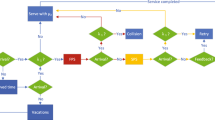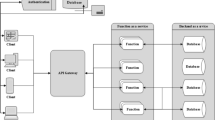Abstract
This paper studies customer joining behavior and system regulation strategy in non-exhaustive visible M/M/m queues with synchronous vacations of a part of the servers. Once this part of the servers are idle, they take multiple vacations simultaneously (vacation period). Until there are customers waiting in the queue, they are reactivated and all servers are busy or idle (busy period). The authors call this part of the servers as “partial servers”. In view of the fully visible queue and the almost visible queue, the authors obtain customers’ equilibrium joining threshold strategies and their socially optimal joining threshold strategies, respectively, and observe that customer joining behavior in equilibrium generally makes the system overcrowded, which makes the equilibrium social welfare lower than the optimal social welfare. After regulation, interestingly, for optimizing social welfare, the system manager hopes not only customers arriving in vacation period pay attention to the number of partial servers, but also customers arriving in busy period should care about it rather than ignore. Moreover, arranging more servers for vacation does not necessarily lead to the decrease of social welfare on condition that the number of partial servers is close to m. As for the information advantage of the fully visible case, it is not obvious for increasing social welfare and even unfavorable to servers’ profit unless the number of partial servers is big enough. Furthermore, given the different composition of social welfare, there exists the optimal number of partial servers and the optimal arrival rate of customers for maximizing social welfare.
Similar content being viewed by others
References
Naor P, The regulation of queue size by levying tolls, Econometrica, 1969, 37: 15–24.
Yechiali U, On optimal balking rules and toll charges in the GI/M/1 queuing process, Operations Research, 1971, 19(2): 349–370.
Edelson N and Hildebrand K, Congestion tolls for Poisson queueing processes, Econometrica, 1975, 43: 81–92.
Hassin R and Haviv M, To Queue or Not to Queue: Equilibrium Behavior in Queueing Systems, Kluwer Academic Publishers, Boston, 2003.
Hassin R, Rational Queueing, CRC Press, Boca Raton, 2016.
Wang J T, Cui S L, and Wang Z B, Equilibrium strategies in M/M/1 priority queues with balking, Production and Operations Management, 2019, 28(1): 43–62.
Wang J T, Wang Z B, and Chen Y, Equilibrium strategies and optimal pricing in an online retailing queueing system, Naval Research Logistics, 2021, 68(5): 556–576.
Dvir N, Hassin R, and Yechiali U, Strategic behaviour in a tandem queue with alternating server, Queueing Systems, 2020, 96(3–4): 205–244.
Kerner Y and Shmuel-Bittner O, Strategic behavior and optimization in a hybrid M/M/1 queue with retrials, Queueing Sytems, 2020, 96(3–4): 285–302.
Benioudakis M, Burnetas A, and Ioannou G, Lead-time quotations in unobservable make-to-order systems with strategic customers: Risk aversion, load control and profit maximization, European Journal of Operational Research, 2021, 289(1): 165–176.
Wang Z B, Fang L, and Zhu S, Strategic behavior in queues with the effect of the number of customers behind, Operations Research Letters, 2020, 48(5): 646–651.
Srinivas S and Marathe R, Equilibrium in a finite capacity M/M/1 queue with unknown service rates consisting of strategic and non-strategic customers, Queueing Systems, 2020, 96(3–4): 329–356.
Safwat M and Hesham E, Strategic behavior for spectrum access in hybrid overlay/underlay cognitive radio networks, IET Communications, 2018, 12(9): 1108–1115.
Burnetas A and Economou A, Equilibrium customer strategies in a single server Markovian queue with setup times, Queueing Systems, 2007, 56(3–4): 213–228.
Guo P F and Hassin R, Strategic behavior and social optimization in Markovian vacation queues, Operations Research, 2011, 59(4): 986–997.
Guo P F and Hassin R, Strategic behavior and social optimization in Markovian vacation queues: The case of heterogeneous customers, European Journal of Operational Research, 2012, 222(2): 278–286.
Zhang F, Wang J T, and Liu B, Equilibrium balking strategies in Markovian queues with working vacations, Applied Mathematical Modelling, 2013, 37(16–17): 8264–8282.
Sun W and Li S Y, Equilibrium and optimal behavior of customers in Markovian queues with multiple working vacations, Top, 2014, 22(2): 694–715.
Sun W, Li S Y, and Li Q L, Equilibrium balking strategies of customers in Markovian queues with two-stage working vacations, Applied Mathematics and Computation, 2014, 248: 195–214.
Guha D, Goswami V, and Banik A, Equilibrium balking strategies in renewal input batch arrival queues with multiple and single working vacation, Performance Evaluation, 2015, 94: 1–24.
Manou A, Canbolat P, and Karaesmen F, Pricing in a transportation station with strategic customers, Production and Operations Management, 2017, 26(9): 1632–1645.
Bountali O and Economou A, Equilibrium joining strategies in batch service queueing systems, European Journal of Operational Research, 2017, 260(3): 1142–1151.
Bountali O and Economou A, Equilibrium threshold joining strategies in partially observable batch service queueing systems, Annals of Operations Research, 2019, 277(2): 231–253.
Bountali O and Economou A, Strategic customer behavior in a two-stage batch processing system, Queueing Systems, 2019, 93(1–2): 3–29.
Bu Q H, Sun Y, Chai X D, et al., Strategic behavior and social optimization in a clearing queueing system with N-policy and stochastic restarting scheme, Applied Mathematics and Computation, 2020, 381: 125309.
Economou A and Manou A, Equilibrium balking strategies for a clearing queueing system in alternating environment, Annals of Operations Research, 2013, 208(1): 489–514.
Guo P F and Zhang Z G, Strategic queueing behavior and its impact on system performance in service systems with the congestion-based staffing policy, Manufacturing & Service Operations Management, 2013, 15(1): 118–131.
Li X, Li Q Y, Guo P F, et al., On the uniqueness and stability of equilibrium in quality-speed competition with boundedly-rational customers: The case with general reward function and multiple servers, International Journal of Production Economics, 2017, 193: 726–736.
Li Q Y, Guo P F, and Wang Y L, Equilibrium analysis of unobservable M/M/n priority queues with balking and homogeneous customers, Operations Research Letters, 2020, 48(5): 674–681.
Jin S F, Wu H X, and Yue W Y, Pricing policy for a cloud registration service with a novel cloud architecture, Cluster Computing, 2019, 22(1): 271–283.
Fu L W and Jin S F, Nash equilibrium and social optimization in cloud service systems with diverse users, Cluster Computing, 2021, 24(3): 2039–2050.
Tian N S and Zhang Z G, Vacation Queueing Models: Theory and Applications, Springer-Verlag, New York, 2006.
Guha D, Goswami V, and Banik A, Algorithmic computation of steady-state probabilities in an almost observable GI/M/c queue with or without vacations under state dependent balking and reneging, Applied Mathematical Modelling, 2016, 40(5–6): 4199–4219.
Wang J T, Zhang Y, and Zhang Z G, Strategic joining in an M/M/K queue with asynchronous and synchronous multiple vacations, Journal of the Operational Reseach Society, 2019, 72(1): 161–179.
Jin S F, Wu H X, Yue W Y, et al., Performance evaluation and Nash equilibrium of a cloud architecture with a sleeping mechanism and an enrollment service, Journal of Industrial and Management Optimization, 2020, 16(5): 2407–2424.
Author information
Authors and Affiliations
Corresponding author
Ethics declarations
The authors declare no conflict of interest.
Additional information
This research was supported by the National Natural Science Foundation of China under Grant No. 71971188, the Humanities and Social Science Fund of Ministry of Education of China under Grant No. 22YJCZH086, and the Hebei Natural Science Foundation under Grant Nos. G2023203008 and G2022203003.
Rights and permissions
About this article
Cite this article
Sun, W., Wang, H., Xie, X. et al. Customer Joining Behavior and Regulation Strategy in Visible Multi-Server Queues with Synchronous Vacations of Partial Servers. J Syst Sci Complex 37, 1209–1232 (2024). https://doi.org/10.1007/s11424-024-2143-2
Received:
Revised:
Published:
Issue Date:
DOI: https://doi.org/10.1007/s11424-024-2143-2




